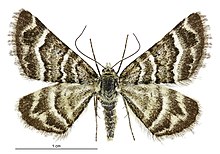| Notoreas paradelpha | |
|---|---|

| |
| Female | |

| |
| Male | |
| Scientific classification | |
| Domain: | Eukaryota |
| Kingdom: | Animalia |
| Phylum: | Arthropoda |
| Class: | Insecta |
| Order: | Lepidoptera |
| Family: | Geometridae |
| Genus: | Notoreas |
| Species: | N. paradelpha |
| Binomial name | |
| Notoreas paradelpha (Meyrick, 1883) | |
| Synonyms | |
| |
Notoreas paradelpha is a species of moth in the family Geometridae. It is endemic to New Zealand.
Taxonomy
This species was first described in 1883 by Edward Meyrick using material collected by him on Ben Lomond near Lake Wakatipu in December. He named the species Pasithea paradelpha. In 1884 Meyrick went on to give a more detailed description of the species. In 1886 Meyrick renamed the genus to which he had previously assigned this species and placed it within the genus Notoreas. George Hudson discussed and illustrated this species both in his 1898 book New Zealand Moths and Butterflies (Macro-lepidoptera) and in his 1928 book The Butterflies and Moths of New Zealand.
The genus Notoreas was reviewed in 1986 by R. C. Craw and the placement of this species within it was confirmed. However species within the genus Notoreas are currently regarded as being in need of revision. The lectotype specimen is held at the Natural History Museum, London.
Description
Meyrick described the species as follows:
Male. — 21-23 mm. Forewings moderate, costa straight, hindmargin rounded; dark fuscous, densely and finely strewn with yellowish and a few whitish scales; a curved cloudy whitish line towards base, anteriorly blackish-margined; a slightly bent whitish line at 1⁄3, posteriorly blackish-margined; sometimes a small blackish discal dot, and slender curved median line; a clearly marked white line beyond middle, anteriorly strongly blackish-margined, shortly and obtusely angulated in middle, and inner margin shortly toothed above and below middle; an irregular sinuate subdentate whitish-yellowish subterminal line: cilia with basal half dark grey, apical half sharply barred with dark fuscous and white. Hindwings somewhat elongate, hindmargin rounded; dark fuscous; basal half irrorated with pale yellowish; a very obscure curved whitish shade before middle; a well-defined strongly-curved white median line; a very irregular subdentate whitish-yellowish subterminal line; cilia as in forewings.
Distribution
N. paradelpha is endemic to New Zealand. Along with its type locality of Ben Lomond, N. paradelpha has also been found on Mount Arthur, Arthur's Pass, the Hunter Mountains and at Obelisk Station and the Dansey Ecological District in Otago.
Life cycle and behaviour
The female moth lays her eggs within the flower buds of their host plant. When the larvae emerge from their eggs, they eat into the leaves or buds of their host, hiding from predators. Once they are large enough, they emerge to feed from the fresh growth of the plant. N. paradelpha pupate in a loose cocoon on the ground under their host. N. paradelpha are day-flying moths. They are low but fast flyers and constantly vibrate their wings to enable them to take off rapidly.
Adults are on the wing from November to February.
Habitat and host species
This moth species prefers to live in high alpine habitat and has been found amongst grass and in herbfields. The host plants for the larvae of N. paradelpha are the endemic species in the genera Kelleria and Pimelea including Pimelia oreophila.
References
- ^ "Notoreas paradelpha (Meyrick, 1883)". www.nzor.org.nz. Manaaki Whenua - Landcare Research. Retrieved 13 December 2018.
- Meyrick, E. (1883). "Descriptions of New Zealand Microlepidoptera". New Zealand Journal of Science. 1: 526–531 – via Biodiversity Heritage Library.
- ^ Meyrick, E. (May 1884). "A Monograph of the New Zealand Geometrina". Transactions and Proceedings of the New Zealand Institute. 16: 49–113 – via Biodiversity Heritage Library.
- ^ Dugdale, John S. (23 September 1988). Lepidoptera - annotated catalogue, and keys to family-group taxa (PDF). Vol. 14. pp. 1–264. ISBN 978-0-477-02518-8. Archived from the original (PDF) on 27 January 2019. Retrieved 13 December 2018 – via Manaaki Whenua - Landcare Research.
{{cite book}}:|journal=ignored (help) - Meyrick, E. (1886). "Notes on Nomenclature of New Zealand". Transactions and Proceedings of the New Zealand Institute. 18: 184 – via Biodiversity Heritage Library.
- ^ Hudson, G. V. (1898). New Zealand Moths and Butterflies (Macro-lepidoptera). London. p. 72. doi:10.5962/bhl.title.32466. OCLC 727236768. Retrieved 12 December 2018.
{{cite book}}: CS1 maint: location missing publisher (link) - ^ Hudson, G. V. (1928). The Butterflies and Moths of New Zealand. Wellington: Ferguson & Osborn Ltd. pp. 124–125. OCLC 25449322.
- Craw, R.C. (5 January 2012). "Review of the genus Notoreas (sensu auctorum) (Lepidoptera: Geometridae: Larentiinae)". New Zealand Journal of Zoology. 13 (1): 131–140. doi:10.1080/03014223.1986.10422654.
- Hoare, R. J. B.; Rhode, B. E.; Emmerson, A. W. (2011). "Larger moths of New Zealand: Image gallery and online guide". Manaaki Whenua Landcare Research. Retrieved 13 December 2018.
- Gordon, Dennis P., ed. (2010). New Zealand inventory of biodiversity: Kingdom animalia: chaetognatha, ecdysozoa, ichnofossils. Vol. 2. p. 460. ISBN 978-1-877257-93-3. OCLC 973607714. OL 25288394M. Wikidata Q45922947.
- Hudson, G.V. (1889). "An Entomological Tour on the Table-land of Mount Arthur". Transactions and Proceedings of the New Zealand Institute. 22: 179–186 – via Biodiversity Heritage Library.
- ^ "Obelisk Station Crown Pastoral Land Tenure Review: Conservation Resources Report - Part 4". www.linz.govt.nz/. Land Information New Zealand. December 2010. p. 9. Retrieved 13 December 2017.
- ^ Patrick, Brian H. (1991). Insects of the Dansey Ecological District (PDF). Wellington : Department of Conservation. pp. 7, 8, 18. ISBN 978-0478012859. ISSN 0113-3713. OCLC 154612987.
- ^ Patrick, Brian (Autumn 2015). "Discovering New Zealand's gorgeous moths" (PDF). Butterflies and Moths of New Zealand. New Zealand: Butterflies and Moths of New Zealand Trust. p. 13. Retrieved 12 December 2018.
- "Invertebrate herbivore biodiversity assessment - Notoreas paradelpha". plant-synz.landcareresearch.co.nz. Manaaki Whenua - Landcare Research. Retrieved 13 December 2018.
| Taxon identifiers | |
|---|---|
| Notoreas paradelpha | |